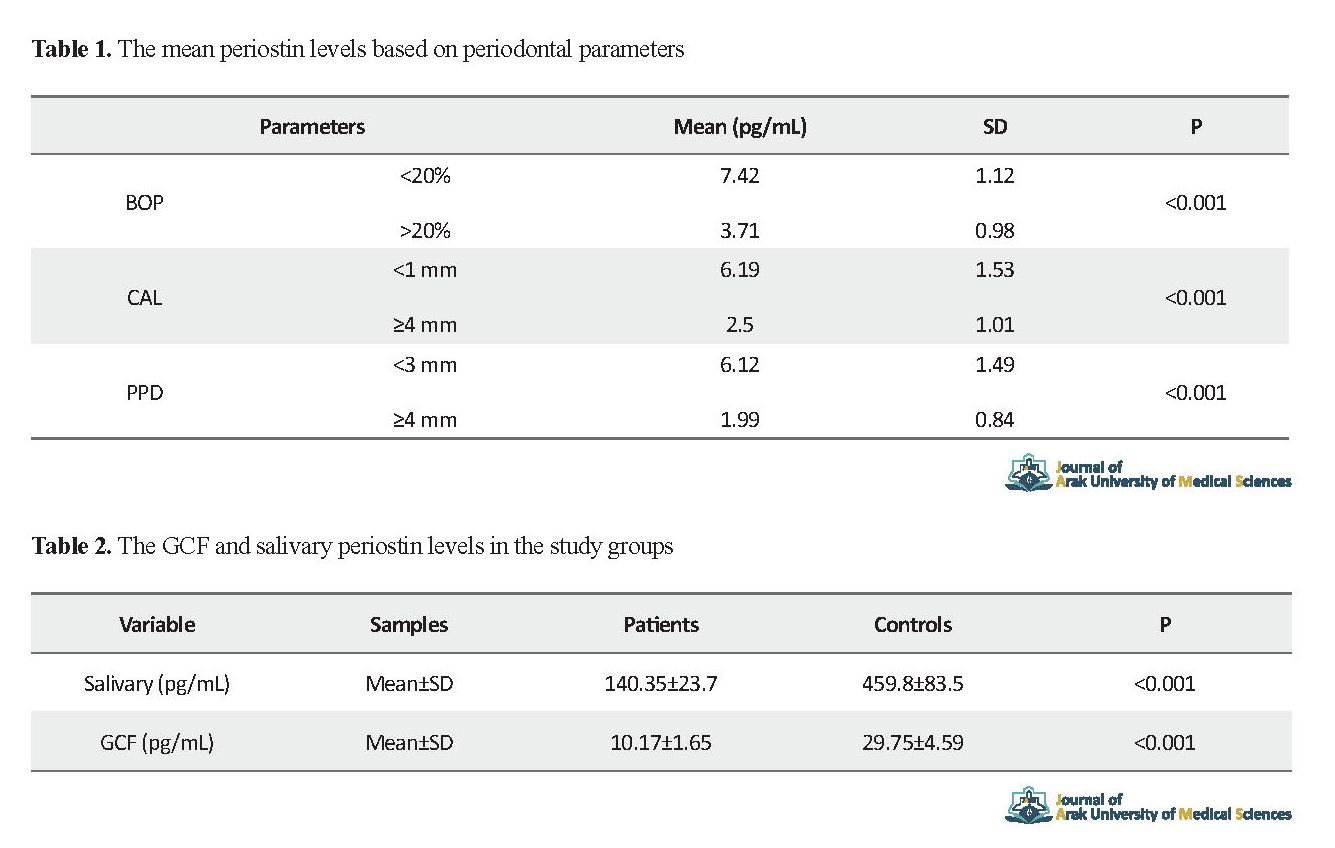Volume 23, Issue 1 (April & May 2020)
J Arak Uni Med Sci 2020, 23(1): 72-81 |
Back to browse issues page
Download citation:
BibTeX | RIS | EndNote | Medlars | ProCite | Reference Manager | RefWorks
Send citation to:



BibTeX | RIS | EndNote | Medlars | ProCite | Reference Manager | RefWorks
Send citation to:
Momeni F, Nakhostin A, Bayani M. Comparison of Salivary and Gingival Crevicular Fluid Periostin Levels in Chronic Periodontitis Patients and Healthy Subjects. J Arak Uni Med Sci 2020; 23 (1) :72-81
URL: http://jams.arakmu.ac.ir/article-1-6135-en.html
URL: http://jams.arakmu.ac.ir/article-1-6135-en.html
1- Student Research Center, Arak University Medical Sciences, Arak, Iran.
2- School of Dentistry, Arak University of Medical Sciences, Arak, Iran.
3- Department of Periodontics, Faculty of Dentistry, Arak University of Medical Sciences, Arak, Iran. , mbayani@mail.com
2- School of Dentistry, Arak University of Medical Sciences, Arak, Iran.
3- Department of Periodontics, Faculty of Dentistry, Arak University of Medical Sciences, Arak, Iran. , mbayani@mail.com
Full-Text [PDF 3442 kb]
(816 Downloads)
| Abstract (HTML) (2000 Views)
Full-Text: (1451 Views)
Extended Abstract
Introduction
Periodontitis is an inflammatory disorder of the periodontium that affects the tooth-supporting tissues. It is characterized by loss of gingival adhesions and, in more advanced stages of the disease, alveolar bone resorption [1]. Periostin is a matriarchal protein secreted by periodontal ligament fibroblasts [3]. The role of periostin in tooth development is very important [4]. In some studies, the study of Gingival Crevicular Fluid (GCF) has also been proposed for measuring the presence of periodontitis [8]. Some studies have reported an association between the severity of periodontitis and periostin level [12-10]. Since contradictory results have reported for the relationship between them and also due to the lack of studies measured both salivary and GCF periostin levels, this study aimed to examine GCF and salivary periostin levels in patients with chronic Periodontitis compared to controls.
Materials and Methods
This matched case-control study was conducted on 53 patients with chronic periodontitis and 53 healthy peers. Three periodontal parameters were evaluated and recorded for each patient: Bleeding on Probing (BOP) [3], Clinical Attachment Level (CAL) [13], and Probing Pocket Depth (PPD). All evaluations were performed by a periodontist. In patients, only one site was selected for sampling, while several sites were selected for sampling in controls to ensure that a sufficient amount of gingival fluid was collected. For sampling, an absorbent paper cone was inserted into the gingival crevice and left in position for one minute. After absorbing the fluid, we slowly removed the paper cone. The salivary sample was collected by using spitting method. All samples were evaluated by ELISA technique. Independent t-test at 95% confidence interval was used to investigate the difference between the mean levels of periostin in the two groups and also to compare the mean levels of periostin based on periodontal parameters.
Results
The distribution of age, sex, weight, and body mass index were the same in both groups, and there was no significant difference between them. However, there was a significant difference between the two groups in terms of BOP, CAL, and PPD (P<0.001). The mean periostin levels are shown in Table 1 based on periodontal parameters. As can be seen, mean periostin level was significantly higher in case of BOP <20%, CAL<1 mm, and PPD <3 mm (P<0.001). The mean GCF and salivary periostin levels in both groups are presented in Table 2. As can be seen, there is a significant difference in GCF and salivary periostin levels between study groups (P<0.001).
Introduction
Periodontitis is an inflammatory disorder of the periodontium that affects the tooth-supporting tissues. It is characterized by loss of gingival adhesions and, in more advanced stages of the disease, alveolar bone resorption [1]. Periostin is a matriarchal protein secreted by periodontal ligament fibroblasts [3]. The role of periostin in tooth development is very important [4]. In some studies, the study of Gingival Crevicular Fluid (GCF) has also been proposed for measuring the presence of periodontitis [8]. Some studies have reported an association between the severity of periodontitis and periostin level [12-10]. Since contradictory results have reported for the relationship between them and also due to the lack of studies measured both salivary and GCF periostin levels, this study aimed to examine GCF and salivary periostin levels in patients with chronic Periodontitis compared to controls.
Materials and Methods
This matched case-control study was conducted on 53 patients with chronic periodontitis and 53 healthy peers. Three periodontal parameters were evaluated and recorded for each patient: Bleeding on Probing (BOP) [3], Clinical Attachment Level (CAL) [13], and Probing Pocket Depth (PPD). All evaluations were performed by a periodontist. In patients, only one site was selected for sampling, while several sites were selected for sampling in controls to ensure that a sufficient amount of gingival fluid was collected. For sampling, an absorbent paper cone was inserted into the gingival crevice and left in position for one minute. After absorbing the fluid, we slowly removed the paper cone. The salivary sample was collected by using spitting method. All samples were evaluated by ELISA technique. Independent t-test at 95% confidence interval was used to investigate the difference between the mean levels of periostin in the two groups and also to compare the mean levels of periostin based on periodontal parameters.
Results
The distribution of age, sex, weight, and body mass index were the same in both groups, and there was no significant difference between them. However, there was a significant difference between the two groups in terms of BOP, CAL, and PPD (P<0.001). The mean periostin levels are shown in Table 1 based on periodontal parameters. As can be seen, mean periostin level was significantly higher in case of BOP <20%, CAL<1 mm, and PPD <3 mm (P<0.001). The mean GCF and salivary periostin levels in both groups are presented in Table 2. As can be seen, there is a significant difference in GCF and salivary periostin levels between study groups (P<0.001).
Discussion
The study simultaneously measured the GCF and salivary periostin levels of patients with chronic periodontitis compared to the healthy peers. Periostin plays a key role in the development of tooth-supporting tissues [17-15]. In a study conducted by Balli et al., and Rezaei et al., the serum and GCF periostin levels in patients with periodontitis were significantly lower than in the healthy group [10, 18]. This is consistent with our results. In another study, the GCF periostin levels of patients with chronic and aggressive periodontitis were compared with healthy people. The results showed the high GCF periostin levels of patients compared to control, where it was lower in patients aggressive Periodontitis compared to those with chronic Periodontitis [21]. In our study, both GCF and salivary periostin levels were lower in patients compared to controls. Periostin may act as a potential biomarker for the diagnosis of periodontitis. Therefore, in practice, it can probably be used to predict and thus prevent the progression of this disease.
Ethical Considerations
Compliance with ethical guidelines
This study was conducted after obtaining an ethical approval (Code: IR.ARAKMU.REC.1397.3) from the Research Ethics Committee of Arak University of Medical Sciences, and a written consent from the participants.
Funding
This study was financially supported by the Deputy for Research and Technology of Arak University of Medical Sciences.
Authors' contributions
Scientific design and management: Mojtaba Bayani; Design and implementation: Afrooz Nakhostin; Implementation of practical research process and writing: Mojtaba Bayani, Fatemeh Momeni.
Conflicts of interest
The authors declare no conflict of interest.
Acknowledgements
The authors would like to thank the Deputy for Research of Arak University of Medical Sciences for their financial support.
The study simultaneously measured the GCF and salivary periostin levels of patients with chronic periodontitis compared to the healthy peers. Periostin plays a key role in the development of tooth-supporting tissues [17-15]. In a study conducted by Balli et al., and Rezaei et al., the serum and GCF periostin levels in patients with periodontitis were significantly lower than in the healthy group [10, 18]. This is consistent with our results. In another study, the GCF periostin levels of patients with chronic and aggressive periodontitis were compared with healthy people. The results showed the high GCF periostin levels of patients compared to control, where it was lower in patients aggressive Periodontitis compared to those with chronic Periodontitis [21]. In our study, both GCF and salivary periostin levels were lower in patients compared to controls. Periostin may act as a potential biomarker for the diagnosis of periodontitis. Therefore, in practice, it can probably be used to predict and thus prevent the progression of this disease.
Ethical Considerations
Compliance with ethical guidelines
This study was conducted after obtaining an ethical approval (Code: IR.ARAKMU.REC.1397.3) from the Research Ethics Committee of Arak University of Medical Sciences, and a written consent from the participants.
Funding
This study was financially supported by the Deputy for Research and Technology of Arak University of Medical Sciences.
Authors' contributions
Scientific design and management: Mojtaba Bayani; Design and implementation: Afrooz Nakhostin; Implementation of practical research process and writing: Mojtaba Bayani, Fatemeh Momeni.
Conflicts of interest
The authors declare no conflict of interest.
Acknowledgements
The authors would like to thank the Deputy for Research of Arak University of Medical Sciences for their financial support.
Type of Study: Original Atricle |
Subject:
Basic Sciences
Received: 2019/08/25 | Accepted: 2020/01/25
Received: 2019/08/25 | Accepted: 2020/01/25
Send email to the article author
| Rights and permissions | |
 |
This work is licensed under a Creative Commons Attribution-NonCommercial 4.0 International License. |










